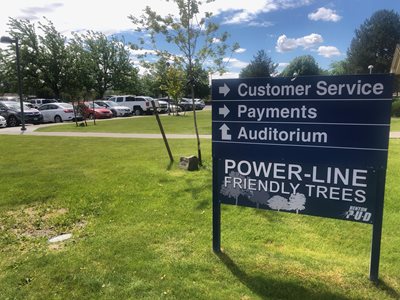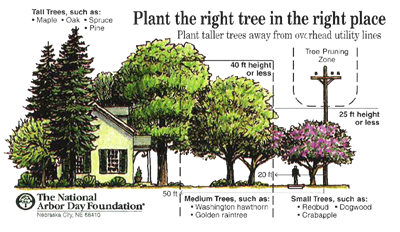Trees are an important part of our community and add to our quality of life. They add to your home value, provide shade and help improve your home’s energy efficiency. Trees also play an important part of carbon reduction in our environment.
If not properly cared for trees may cause hazardous situations. Tree branches growing into electrical lines can cause power outages, property damage or personal injury. These hazards can be prevented by planting appropriately near power lines, proper tree pruning and in some cases, removal and replanting of “power line friendly” trees.
It is Benton PUD’s practice to prune and/or remove trees in close proximity to primary high-voltage overhead lines. Customers are responsible for pruning and/or removing trees growing into secondary lines that go directly to your home or business as well as maintaining access to underground electrical equipment. Contact us prior to pruning near secondary lines to request that we disconnect your service. We will disconnect your service free of charge during regular work hours to allow you to prune your trees safely.
Benton PUD’s tree program was developed to ensure quality tree care practices and help customers plant the right trees near utility lines and equipment. The benefits of the program have been healthier trees, less outages and long-term savings to Benton PUD.
Power-line friendly trees

Benton PUD displays trees that are safe to plant near power lines outside of our office in Kennewick. Come take a look. You can find them to the left of the lobby. It’s important to practice electrical safety when landscaping your home this Spring and plant trees that are slow growing near power lines so you don’t run into issues with utility equipment.
Click here for a list of recommended trees.
Right Tree Right Location

Tree branches growing into electrical lines can cause power outages, property damage, or personal injury. With proper planning you can help prevent these hazards. The rule of thumb, plant taller trees furthest away from overhead utility lines.
Small Zone
This utility-friendly zone is only for trees and shrubs that grow no more than 25 feet tall. These are called Class I trees.
Medium Zone
This zone is 20 to 50 feet away from a power pole and line. Here, mature trees should be no more than 40 feet tall. The extra space reduces the chance of tree branches or roots from contacting overhead or underground lines. Look for Class II trees to plant in this zone.
Tall Zone
This zone is at least 50 feet or more away from a power line or pole. It is the only zone
where you should plant trees that grow over 40 feet tall. These are Class III trees.
Know What's Below
Trees, shrubs and other forms of vegetation that grow too close to electrical equipment can cause problems for our crews and may need to be removed to allow crew access. Taking time to remove plantings delays our response time to an outage or other electrical emergency. Make sure to leave at least 10 feet from the front side of any equipment and three feet from the other three sides when your plants are fully grown.
Call Before You Dig
If you are planning to do any digging the first thing you want to do is call 8-1-1 for the Utilities Underground Location Center. They will send someone to mark where your electric, gas, water, sewer and cable lines are buried. The last thing you want to do is to hit one of these lines, causing a dangerous and expensive problem.
For more information
If you have any questions about our tree program, pruning trees, and/or planting the right tree, please call Benton PUD Utility Tree Coordinator, Brian Cramer, at (509) 585-5399 or email him at cramerb@bentonpud.org.
Benton PUD is recipient of the Tree Line USA award for our commitment to quality tree care practices, public education regarding tree planting for energy conservation and appropriate placement near utility lines and community tree planting.